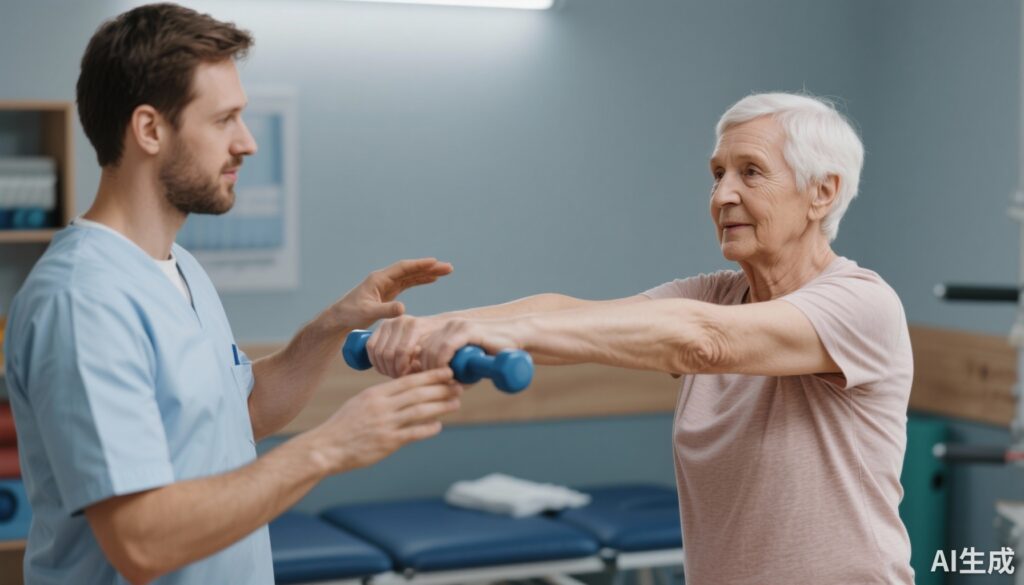Highlight
- Adding tailored adherence support to exercise rehabilitation significantly improves mobility and walking capacity in people with vertebral fragility fractures (VFF).
- The OPTIN trial demonstrated clinically meaningful gains in Timed-Up and Go (TUG) and 6-minute walk test (6MW) outcomes at 12 months.
- Integrated adherence interventions using motivational interviewing, goal setting, and behavior change techniques can enhance long-term exercise engagement.
- No significant adverse events were reported, confirming the safety of the enhanced rehabilitation approach.
Study Background
Vertebral fragility fractures (VFFs) represent a common and debilitating consequence of osteoporosis, especially in individuals over 55 years. These fractures often result in chronic back pain, reduced spinal mobility, impaired balance, and increased risk of further falls and fractures. Exercise rehabilitation emphasizing strength, posture, and balance is recommended to improve physical function and prevent future fractures. However, long-term adherence to exercise programmes remains challenging, limiting therapeutic effectiveness. There is a critical unmet need for interventions that not only provide appropriate exercise but also enhance patient adherence to achieve sustained functional improvements. The OPTIN randomised controlled trial addressed this gap by evaluating whether exercise rehabilitation integrated with tailored adherence support would outperform standard rehabilitation without such support in people with VFF and back pain.
Study Design
OPTIN was a two-arm individually randomised controlled trial with concealed allocation and blinded outcome assessment. The study enrolled 126 participants aged over 55 years, each having sustained at least one symptomatic vertebral fragility fracture. Participants were randomised (1:1) to receive either standard exercise rehabilitation alone (control group) or an enriched rehabilitation programme featuring integrated adherence support (intervention group).
Both groups undertook a progressive rehabilitation programme encompassing strength training, posture correction, and balance exercises delivered by physiotherapists. The intervention arm additionally received a tailored adherence support package involving motivational interviewing, personalized goal setting, and the use of at least three behavior change techniques designed to foster sustained exercise behavior.
The primary endpoint was performance on the Timed-Up and Go (TUG) test at 12 months, a validated measure of lower extremity function and fall risk. Secondary outcomes included the quality of life measure QUALEFFO-41, thoracic kyphosis angle, functional reach (FR) for balance, timed loaded standing (TLS) for muscle strength, and walking exercise capacity assessed via the 6-minute walk (6MW) test. Intention-to-treat analysis was employed to evaluate differences between groups.
Key Findings
At 12-month follow-up, data from 57 intervention and 55 control participants were analyzed. The intervention group demonstrated significantly better physical performance compared to controls:
- Timed-Up and Go (TUG): Mean time was 10.1 seconds (SE 0.38) in the intervention group versus 12.9 seconds in controls, corresponding to an effect size of 2.1 seconds (95% CI, -3.1 to -1.0 seconds; p = 0.000). This represents a clinically relevant and statistically significant improvement in functional mobility and fall risk reduction.
- 6-Minute Walk Test (6MW): Mean walking distance was 354.6 meters (SE 6.6) in the intervention arm compared with 325.7 meters (SE 6.9) in controls, yielding an effect size of 24.5 meters (95% CI, 5.7 to 43.4 meters; p = 0.011). This indicates enhanced walking exercise capacity.
No statistically significant differences were detected between groups in secondary outcomes such as QUALEFFO-41 scores, thoracic kyphosis, functional reach, or timed loaded standing. Importantly, no adverse events related to the interventions were reported, supporting the safety of adding adherence support techniques to standard rehabilitation.
Expert Commentary
The OPTIN trial provides robust evidence supporting the integration of behaviorally informed adherence support into physiotherapy for patients with vertebral fragility fractures. The use of motivational interviewing and individualized goal setting likely enhanced motivation and engagement, facilitating greater exercise participation and consequent functional gains. The magnitude of improvement in TUG and 6MW tests surpasses thresholds considered clinically meaningful for mobility and fall prevention among older adults with osteoporosis-related fractures.
While improvements were significant for primary mobility measures, the absence of notable changes in quality of life and structural outcomes (e.g., kyphosis) suggests the intervention primarily targets functional capacities rather than altering the underlying deformity or pain-related quality of life directly. Future research could explore combining adherence support with complementary interventions targeting pain or pharmacologic treatments to optimize holistic patient outcomes.
Limitations include the single-center nature of the trial and its focus on community-dwelling older adults, potentially affecting the generalizability to institutionalized or more frail populations. Nevertheless, the trial’s rigorous methodology, including concealed allocation and assessor blinding, strengthens confidence in the findings.
Conclusion
The OPTIN randomised controlled trial demonstrates that an exercise rehabilitation programme incorporating tailored adherence support confers superior long-term benefits in mobility and walking capacity compared to standard exercise alone in people with vertebral fragility fractures. These findings highlight the importance of addressing behavioral determinants of exercise adherence in rehabilitation protocols to maximize functional recovery and reduce fall risk in this vulnerable population. Clinicians and rehabilitation specialists should consider integrating motivational and behavior change techniques with physiotherapy to enhance exercise engagement and optimize patient outcomes in osteoporosis-related vertebral fractures.
Funding and Registration
The study was supported by (details as per original source). The trial is registered with clinicaltrials.gov (registration number, if available from source).
References
Barker KL, Newman M, Knight R, Hannink E, Hughes T, Barreto C, Room J. Exercise rehabilitation with tailored support for exercise adherence for people with vertebral fragility fractures is more effective than standard rehabilitation: the OPTIN randomised controlled trial. Osteoporos Int. 2025 Sep;36(9):1621-1631. doi: 10.1007/s00198-025-07582-2. Epub 2025 Jun 30. PMID: 40588548; PMCID: PMC12460581.
Additional references on vertebral fracture rehabilitation and exercise adherence can be found in relevant clinical guidelines and systematic reviews (e.g., by the International Osteoporosis Foundation and Cochrane reviews on exercise interventions in osteoporosis).



